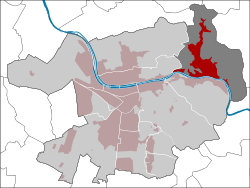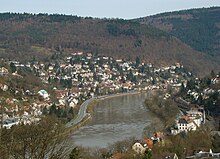Ziegelhausen
|
Ziegelhausen district of Heidelberg |
|
|---|---|
| Coordinates | 49 ° 25 '6 " N , 8 ° 45' 24" E |
| surface | 14.73 km² |
| Residents | 9634 (2017) |
| Population density | 654 inhabitants / km² |
| District number | 014 |
| structure | |
| Townships |
|
| Source: City of Heidelberg (PDF; 102 kB) | |
Ziegelhausen ( ) is a district of Heidelberg located at the exit of the Neckar Valley .
geography
Ziegelhausen stretches in an east-west direction between the confluences of Bärenbach and Mausbach on the north bank of the Neckar . In north-south direction, it extends from the Dossenheimer Kopf (539 m) to the Neckar (108 m). The size of the district is 1475 ha, 371 ha of which are in Peterstal .
history
Archaeological excavations in Ziegelhausen indicate an early settlement in Roman times . In a document of the Lorsch monastery from the year 850, a settlement with the name "Steimbach" is mentioned in the current area of Ziegelhausen. The nucleus of the village of Ziegelhausen is formed by the brickworks founded by the Cistercian monastery in Schönau in 1210 , the so-called "upper brick house", and the Neuburg Abbey .
The depopulation of the region after the Thirty Years War led to the settlement of Swiss Reformed Protestant denominations as long as the electors belonged to the same denomination. From the eventful religious history of the Palatinate, the “exile” of a Meuter family (still resident today in their descendants) has been passed down. They were supported by the village population and kept secret from the authorities for several years in a sandstone cave outside of Ziegelhausen on Schönauer Strasse, the "Meuters Loch" lived.
The Protestant church was completed in 1733 by Johann Jakob Rischer in the baroque style and the Catholic Church of St. Laurentius was consecrated in 1742. The old churches near the Neckar became too small for the growing communities in the course of the 20th century, so that both denominations built new buildings that, following the expansion of the village, are located further up on the slope in close proximity to each other. The Evangelical Church of Reconciliation was completed in 1975, the Catholic St. Teresa Church in 1997. The old churches were profaned. The Max Berk textile collection is now located in the former Protestant church. There were plans to set up an organ museum for the Laurentius Church, which have not yet been realized.
The Neckar School was opened in 1905. The Neckar Bridge to Schlierbach , built in 1914, connected Ziegelhausen with the train and ended ferry traffic. Peterstal was incorporated in 1936 and a district of Ziegelhausen. In the last days of World War II , the Neckar Bridge was blown up by the Volkssturm in 1945 . This was followed by an artillery battle between American troops on brick houses and German troops on Schlierbach's side.
The new Neckar Bridge was opened to traffic in 1954. The Steinbach School was opened in 1960 and replaced the old school in Peterstal. It was expanded in 1971/72 with a second construction phase and is now operated as a primary and secondary school with a technical secondary school.
On January 1, 1975, the incorporation agreement between the municipality of Ziegelhausen ( Rhein-Neckar district ) and the independent city of Heidelberg came into force, although the residents of Ziegelhausen were overwhelmingly majority in two citizen surveys organized by the municipality of Ziegelhausen (i.e. in the second vote over 80 %) had spoken out in favor of maintaining their independence.
Although the population structure has changed significantly since then, the district has still retained its own village character. This shows u. a. in the lively club life and the numerous festivals, e.g. B. the Kerwe or the carnival events . Long-established brick houses still talk about going “to Heidelberg” when they go to the city center.
economy
Up until the 20th century, Ziegelhausen's clay was used for the production of bricks and bricks. This trade ended with the decline of the steam brickworks Kühner & Cie. Sandstone and porphyry were mined in quarries until the beginning of the 20th century . The hydropower from Steinbach and Bärenbach was used to operate mills, including two powder mills, a paper mill and a hammer mill. The last mill ceased operations in 1925.
In the Mausbach mine , a 460 m long tunnel was driven into the mountain in 1893 to extract manganese ore . The 130 tons of ore extracted were smelted by the Röchling steel works in Völklingen . Due to the poor quality of the ore, mining was stopped again in 1896.
The main business of Ziegelhausen in the 19th and 20th centuries was laundry. The lime-free spring water and the meadows in the Neckar Valley and Steinbachtal (Bleichwiesen) offered ideal conditions for this. The laundries were mostly home and small businesses. The laundry industry reached its peak in 1939 with 230 businesses; today it is just one business.
Away from town, on the banks of the Neckar at the end of the Bärenbach valley, the “Haaf” chocolate factory was located in the premises of the former Stoess gelatine factory from 1939 . From 1956, the parachutist Richard Kohnke produced rescue parachutes on part of the property. Operations ceased in the 1970s. After that, the factory hall was still used as a venue for occasional concerts. Today there is a residential park there.
The red sandstone quarries to the right and left of the Bärenbach valley are still the clearest traces of economic activity today. The Neckar makes a sharp bend there and a steeply sloping impact slope was created, which enabled access to the rock without removing a surface layer. The somewhat smaller fractures can be found on the last 500 meters of Schönauer Straße, where there is also a small viewpoint. Other smaller quarries are distributed above in the forest area, where the "Meuters Loch" is also to be found. More striking quarries extend above the parking lot of the weir, which is on the brick house side towards Kleingemünd on the mountain side.
Other witnesses still visible today are the former forestry and forestry. In the forest directly at the end of the Schönauer Abtweg, furrows up to 3 meters deep are visible in the forest floor, which testify to the removal of felled wood from the same place. In the Bärenbachtal there is the so-called "Boseckerstein" approx. 80 m above the intersection of the eastern Bärenbachtalweg and the Bingheimerlochsteig. A memorial stone was erected there for the forest worker Johann Bosecker, who was killed by a tree on December 19, 1849 while he was working on wood.
politics
The Ziegelhäuser District Advisory Board is composed as follows:
| Party / list | 2019 | 2014 |
|---|---|---|
| Green | 4th | 2 |
| CDU | 3 | 4th |
| SPD | 2 | 3 |
| The left | 1 | - |
| "The Heidelberg" | 1 | 1 |
| FWV | 1 | 1 |
| FDP | 1 | 1 |
| AfD | 1 | 1 |
| generation.hd | - | 1 |
Personalities
Honorary citizen
- The brick house school principal Reinhard Hoppe (1898–1974) made a great contribution as a local homeland researcher. A street is named after him.
Sons and daughters of Ziegelhausen
- The geologist and paleontologist Heinrich Georg Bronn (1800–1862) comes from a brick-house forestry family. The street Förster-Bronn-Weg is named after this family.
- Hermann Remmele (1880–1939), politician (SPD, USPD, KPD), member of the Reichstag
- Udo Kraus (1924–1987), SPD politician, MdL
- Ursel Brunner (* 1941), swimmer
Personalities who have worked on site
- Johann Friedrich Heinrich Schlosser (1780–1851) was a lawyer , imperial councilor, writer , private scholar and privateer
- Christoph Schmezer (1800–1882) was a pastor in Ziegelhausen from 1840 to 1875
- Johannes Brahms (1833–1897) lived in Ziegelhausen in the summer of 1875 in the house of the painter Anton Hanno, and a street is named after him.
- Conrad Johann Glückselig (1864–1934), 1922 Conrad Johann Glückselig ran the "Samaritan Spagyric Laboratory" in Ziegelhausen.
- Rudolph Stratz (1864–1936), novelist, a street is named after him
- Alexander von Bernus (1880–1965), writer and alchemist
- Hermann Buddensieg (1893–1976), writer, editor and translator
- Hans-Georg Gadamer (1900–2002), philosopher
- Joachim Lutz (1906–1954), painter, lived and worked in the porter's house at Stift Neuburg, Stiftweg 3
- Will Sohl (1906–1969), painter, lived and worked in the porter's house at Stift Neuburg, Stiftweg 3
- Robert Stieler (1911–1967), sculptor
- Ilse Rohnacher (1926–2016), dialect poet and writer
- Sebastian Rudy (* 1990), soccer player (TSG 1899 Hoffenheim and German national soccer team)
Individual evidence
- ^ Federal Statistical Office (ed.): Historical municipality directory for the Federal Republic of Germany. Name, border and key number changes in municipalities, counties and administrative districts from May 27, 1970 to December 31, 1982 . W. Kohlhammer, Stuttgart / Mainz 1983, ISBN 3-17-003263-1 , p. 483 .
- ^ City of Heidelberg - District Advisory Board of Ziegelhausen. Retrieved December 11, 2019 .
- ↑ Samaritan Spagyric Laboratory (Conrad Joh. Glückselig), Ziegelhausen near Heidelberg, IX. 1922, List of remedies with indications, Archiv Historisches Vaihingen adFeV
swell
Printed publications:
- Local article on Ziegelhausen in: Staatl. Archive administration Baden-Württemberg in connection with d. Cities and districts Heidelberg u. Mannheim (Hrsg.): The city and districts Heidelberg and Mannheim: Official district description . Volume 3: The city of Heidelberg and the communities in the district of Heidelberg , pp. 1050-1072, Karlsruhe 1968.
- Reinhard Hoppe: 750 years of Ziegelhausen. Heidelberg Publishing House, 1970
- Reinhard Hoppe: The field names of Ziegelhausen. Carl Winter University Press, 1956
- Karl Christ: Chronicle of Ziegelhausen and the Zentwald. 1923
- Reinhard Hoppe: Dorfbuch Ziegelhausen. 1940
- Harald Pfeiffer: Johannes Brahms in Heidelberg and Ziegelhausen. For the composer's 175th birthday. Self publication . Engelsdorfer Verlag, 2008, ISBN 978-3-86703-757-0
- Hans Gercke: Churches in Heidelberg . 1st edition. Schnell and Steiner, Regensburg 2011, ISBN 978-3-7954-2413-8 , pp. 100-102 .
- Norbert Emmerich: Swiss (immigrants) in Heidelberg after the Thirty Years War . Books on Demand GmbH, Norderstedt 2009, ISBN 978-3-8391-1627-2 .
- Melanie Mertens, among others: Stadtkreis Heidelberg (= monument topography Federal Republic of Germany : cultural monuments in Baden-Württemberg. Volume II.5). Volume 2, Jan Thorbecke, Ostfildern 2013, ISBN 978-3-7995-0426-3 , pp. 630–657 (introduction to history and settlement history, description of all cultural monuments in the district).
- Online publications of the district association Ziegelhausen und Peterstal eV:
- Thilde Hoppe: The trades
- Erich J. Lehn: Our Mausbachtal - the mine






